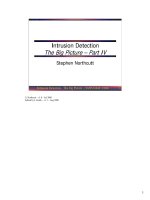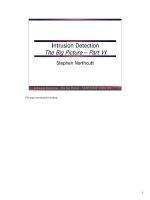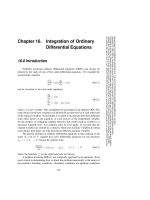Tài liệu Solution of Linear Algebraic Equations part 3 pdf
Bạn đang xem bản rút gọn của tài liệu. Xem và tải ngay bản đầy đủ của tài liệu tại đây (96.03 KB, 3 trang )
2.2 Gaussian Elimination with Backsubstitution
41
Sample page from NUMERICAL RECIPES IN C: THE ART OF SCIENTIFIC COMPUTING (ISBN 0-521-43108-5)
Copyright (C) 1988-1992 by Cambridge University Press.Programs Copyright (C) 1988-1992 by Numerical Recipes Software.
Permission is granted for internet users to make one paper copy for their own personal use. Further reproduction, or any copying of machine-
readable files (including this one) to any servercomputer, is strictly prohibited. To order Numerical Recipes books,diskettes, or CDROMs
visit website or call 1-800-872-7423 (North America only),or send email to (outside North America).
which (peeling of the C
−1
’s one at a time) implies a solution
x = C
1
· C
2
· C
3
···b (2.1.8)
Notice the essential difference between equation (2.1.8) and equation (2.1.6). In the
latter case, the C’s must be applied to b in the reverse order from that in which they become
known. That is, they must all be stored along the way. This requirement greatly reduces
the usefulness of column operations, generally restricting them to simple permutations, for
example in support of full pivoting.
CITED REFERENCES AND FURTHER READING:
Wilkinson, J.H. 1965,
The Algebraic Eigenvalue Problem
(New York:Oxford University Press). [1]
Carnahan, B., Luther, H.A., and Wilkes, J.O. 1969,
Applied Numerical Methods
(New York:
Wiley), Example 5.2, p. 282.
Bevington, P.R. 1969,
Data Reduction and Error Analysis for the Physical Sciences
(New York:
McGraw-Hill), Program B-2, p. 298.
Westlake, J.R. 1968,
A Handbook of Numerical Matrix Inversion and Solution of Linear Equations
(New York: Wiley).
Ralston, A., and Rabinowitz, P. 1978,
A First Course in Numerical Analysis
, 2nd ed. (New York:
McGraw-Hill),
§
9.3–1.
2.2 Gaussian Elimination with Backsubstitution
The usefulness of Gaussian elimination with backsubstitution is primarily
pedagogical. It stands between full elimination schemes such as Gauss-Jordan, and
triangular decomposition schemes such as will be discussed in the next section.
Gaussian elimination reduces a matrix not all the way to the identity matrix, but
only halfway, to a matrix whose components on the diagonal and above (say) remain
nontrivial. Let us now see what advantages accrue.
Suppose that in doing Gauss-Jordan elimination, as described in §2.1, we at
each stage subtract away rows only below the then-current pivot element. When a
22
is the pivot element, for example, we divide the second row by its value (as before),
but now use the pivot row to zero only a
32
and a
42
, not a
12
(see equation 2.1.1).
Suppose, also, that we do only partial pivoting, never interchangingcolumns, so that
the order of the unknowns never needs to be modified.
Then, when we have done this for all the pivots, we will be left with a reduced
equation that looks like this (in the case of a single right-hand side vector):
a
11
a
12
a
13
a
14
0 a
22
a
23
a
24
00a
33
a
34
000a
44
·
x
1
x
2
x
3
x
4
=
b
1
b
2
b
3
b
4
(2.2.1)
Here the primes signify that the a’s and b’s do not have their original numerical
values, but have been modified by all the row operations in the elimination to this
point. The procedure up to this point is termed Gaussian elimination.
42
Chapter 2. Solution of Linear Algebraic Equations
Sample page from NUMERICAL RECIPES IN C: THE ART OF SCIENTIFIC COMPUTING (ISBN 0-521-43108-5)
Copyright (C) 1988-1992 by Cambridge University Press.Programs Copyright (C) 1988-1992 by Numerical Recipes Software.
Permission is granted for internet users to make one paper copy for their own personal use. Further reproduction, or any copying of machine-
readable files (including this one) to any servercomputer, is strictly prohibited. To order Numerical Recipes books,diskettes, or CDROMs
visit website or call 1-800-872-7423 (North America only),or send email to (outside North America).
Backsubstitution
But how do we solve for the x’s? The last x (x
4
in this example) is already
isolated, namely
x
4
= b
4
/a
44
(2.2.2)
With the last x known we can move to the penultimate x,
x
3
=
1
a
33
[b
3
− x
4
a
34
](2.2.3)
and then proceed with the x before that one. The typical step is
x
i
=
1
a
ii
b
i
−
N
j=i+1
a
ij
x
j
(2.2.4)
The procedure defined by equation (2.2.4) is called backsubstitution.Thecom-
bination of Gaussian elimination and backsubstitution yields a solution to the set
of equations.
The advantage of Gaussian elimination and backsubstitutionover Gauss-Jordan
elimination is simply that the former is faster in raw operations count: The
innermost loops of Gauss-Jordan elimination, each containing one subtraction and
one multiplication, are executed N
3
and N
2
M times (where there are N equations
and M unknowns). The corresponding loops in Gaussian elimination are executed
only
1
3
N
3
times (only half the matrix is reduced, and the increasing numbers of
predictable zeros reduce the count to one-third), and
1
2
N
2
M times, respectively.
Each backsubstitution of a right-hand side is
1
2
N
2
executions of a similar loop (one
multiplication plus one subtraction). For M N (only a few right-hand sides)
Gaussian elimination thus has about a factor three advantage over Gauss-Jordan.
(We could reduce this advantage to a factor 1.5 by not computing the inverse matrix
as part of the Gauss-Jordan scheme.)
For computing the inverse matrix (which we can view as the case of M = N
right-hand sides, namely the N unit vectors which are the columns of the identity
matrix),Gaussianeliminationandbacksubstitutionatfirstglancerequire
1
3
N
3
(matrix
reduction) +
1
2
N
3
(right-hand side manipulations) +
1
2
N
3
(N backsubstitutions)
=
4
3
N
3
loop executions, which is more than the N
3
for Gauss-Jordan. However, the
unit vectors are quite special in containing all zeros except for one element. If this
is taken into account, the right-side manipulations can be reduced to only
1
6
N
3
loop
executions, and, for matrix inversion, the two methods have identical efficiencies.
BothGaussian eliminationand Gauss-Jordan eliminationshare thedisadvantage
that all right-hand sides must be known in advance. The LU decomposition method
in the next section does not share that deficiency, and also has an equally small
operations count, both for solution with any number of right-hand sides, and for
matrix inversion. For this reason we will not implement the method of Gaussian
elimination as a routine.
CITED REFERENCES AND FURTHER READING:
Ralston, A., and Rabinowitz, P. 1978,
A First Course in Numerical Analysis
, 2nd ed. (New York:
McGraw-Hill),
§
9.3–1.
2.3 LU Decomposition and Its Applications
43
Sample page from NUMERICAL RECIPES IN C: THE ART OF SCIENTIFIC COMPUTING (ISBN 0-521-43108-5)
Copyright (C) 1988-1992 by Cambridge University Press.Programs Copyright (C) 1988-1992 by Numerical Recipes Software.
Permission is granted for internet users to make one paper copy for their own personal use. Further reproduction, or any copying of machine-
readable files (including this one) to any servercomputer, is strictly prohibited. To order Numerical Recipes books,diskettes, or CDROMs
visit website or call 1-800-872-7423 (North America only),or send email to (outside North America).
Isaacson, E., and Keller, H.B. 1966,
Analysis of Numerical Methods
(New York: Wiley),
§
2.1.
Johnson, L.W., and Riess, R.D. 1982,
Numerical Analysis
, 2nd ed. (Reading, MA: Addison-
Wesley),
§
2.2.1.
Westlake, J.R. 1968,
A Handbook of Numerical Matrix Inversion and Solution of Linear Equations
(New York: Wiley).
2.3 LU Decomposition and Its Applications
Suppose we are able to write the matrix A as a product of two matrices,
L · U = A (2.3.1)
where L is lower triangular (has elements only on the diagonal and below) and U
is upper triangular (has elements only on the diagonal and above). For the case of
a 4 × 4 matrix A, for example, equation (2.3.1) would look like this:
α
11
000
α
21
α
22
00
α
31
α
32
α
33
0
α
41
α
42
α
43
α
44
·
β
11
β
12
β
13
β
14
0 β
22
β
23
β
24
00β
33
β
34
000β
44
=
a
11
a
12
a
13
a
14
a
21
a
22
a
23
a
24
a
31
a
32
a
33
a
34
a
41
a
42
a
43
a
44
(2.3.2)
We can use a decomposition such as (2.3.1) to solve the linear set
A · x =(L·U)·x=L·(U·x)=b (2.3.3)
by first solving for the vector y such that
L · y = b (2.3.4)
and then solving
U · x = y (2.3.5)
What is the advantage of breaking up one linear set into two successive ones?
The advantage is that the solution of a triangular set of equations is quite trivial, as
we have already seen in §2.2 (equation 2.2.4). Thus, equation (2.3.4) can be solved
by forward substitution as follows,
y
1
=
b
1
α
11
y
i
=
1
α
ii
b
i
−
i−1
j=1
α
ij
y
j
i =2,3,...,N
(2.3.6)
while (2.3.5) can then be solved by backsubstitutionexactly as in equations (2.2.2)–
(2.2.4),
x
N
=
y
N
β
NN
x
i
=
1
β
ii
y
i
−
N
j=i+1
β
ij
x
j
i = N − 1,N −2,...,1
(2.3.7)









